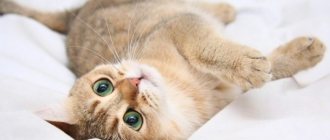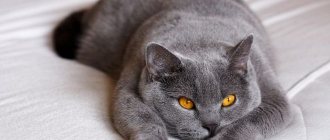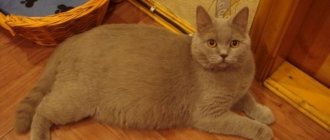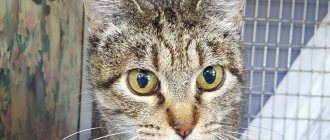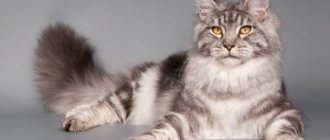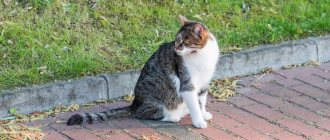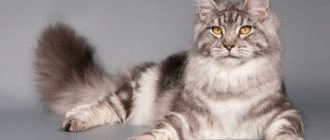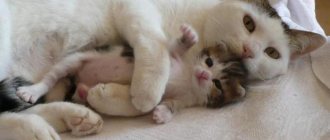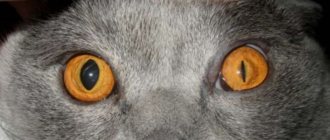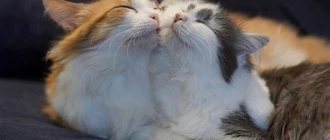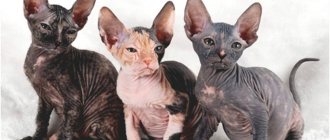Why do domestic cats shed all year round?
Domestic cats live in constant, unchanging conditions all year round. The apartment maintains the same temperature and humidity; the animal does not need to prepare for the approaching cold or, on the contrary, heat. However, it is impossible to completely get rid of molting, the mechanism of which has been formed by evolution over several million years.
Most domestic cats still maintain a periodicity of shedding - they change their coat 2 times a year, but the time of coat change may vary. Some pets, especially long-haired ones, can shed all year round, while others change their coat due to changes in humidity in the apartment. In the fall, when the heating is turned on, the air in the house becomes too dry, which is why the coat begins to change.
Why and how cats shed
Subsequently, molting will become regular. For cats, this is a natural process of preparing for the change of season. Ideally, a cat sheds twice a year:
- before the cold weather begins. Reducing daylight hours and a significant decrease in temperatures include protective mechanisms that involve a change in wardrobe. Cats are rapidly growing a new coat that can protect them from frost. For example, the British grow a powerful, dense undercoat, which is much thicker than the summer one;
- before the onset of heat. Rising temperatures make it necessary to prepare for the summer heat. “Winter” fur, having served its purpose, is no longer needed. Therefore, a lightweight version is growing.
Cats that have free range react most strongly to the change of seasons. Their bodies are exposed to natural weather conditions and are sensitive to the changing seasons.
Cats living in an apartment without walking, despite the lack of seasonality in the home climate, also shed. Only the time of this process is not strictly tied to the environment. Depending on the breed, cats shed 1-2 times a year.
It should be borne in mind that in mature, uncastrated cats, shedding can begin at any time as a reaction to certain changes in physiology. This is how the body will react to hormonal changes during estrus or after kittens are weaned from mother's milk. This is not a reason to panic, you just need to provide your cat with improved nutrition and vitamins.
How long does seasonal molting last?
If you are scared by your kitten's long first molt, don't worry. This is due to complex processes of physiological maturation. Shedding in cats that can be called adults goes back to normal. On average it lasts a couple of months a year. Once in the spring, and again at the end of autumn. There may be minor time shifts in the schedule.
Usually short-haired pets fit into the schedule and timing of shedding. It’s more difficult with the fluffier ones. Persians or Maine Coons, after shedding their guard hairs, take a long time to get rid of the undercoat. They definitely won't be able to do it without your help. If you don't help them with their struggle, the consequences can be serious. From local tangles to completely matted fur.
Sometimes shedding in cats occurs unplanned or does not stop for a long time.
Possible causes of heavy shedding
The reasons why shedding ceases to be seasonal and its period becomes longer in healthy cats may be:
- Keeping a cat in an apartment, especially when it does not have access to the street. The cat continues to shed throughout the year as it loses its seasonal biorhythms. This is due to the fact that the temperature of the apartment does not have seasonal fluctuations, and in winter, with the central heating turned on and the air humidity decreasing, the cat’s shedding even intensifies, despite the fact that the animal is completely healthy and has good nutrition and good care.
- Baby shedding. In six-month-old kittens, soft baby fur is replaced with coarser adult fur, which is thicker, tougher and brighter. At the same time, the patterns on the fur become more contrasting, the existing “points” become bright, and the dullness and softness of the fur characteristic of kittens disappears. Baby shedding lasts 1–2 months and marks the beginning of hormonal maturation. The complete structure of the coat will complete its formation only by 2.5–3 years, and the cat will have well-defined guard hair, undercoat, as well as grooming hair, which serves as an adornment for many breeds and is located on the cheeks, chest, feathers, and tail.
- Pregnancy and breastfeeding. In pregnant and lactating cats, severe shedding may occur, leading to the formation of areas of local alopecia (baldness). This is due to changes in both hormonal levels and metabolism, since the body of a pregnant and then lactating cat directs most of the nutrients it consumes to the formation of kittens, and then to feeding them. After finishing feeding, the cat's fur takes on its previous appearance.
- Elderly age. In older cats, thinning of the coat is observed, the fur becomes less “stuffed”, this is especially noticeable on the head - behind the cat’s ears, as well as on its face.
- Stress. As a rule, the cause of stress in a cat is sudden changes in its environment, getting used to which requires effort from it. This could be a move, the appearance of a new pet, an unkind attitude towards the cat, or even quarrels between people.
- Improper grooming. What is usually important is: selection of shampoo and conditioner for coat care, using them according to the instructions - with a given frequency and correct dilution;
- quality of cat brushes and other grooming tools;
- The frequency of brushing, which differs among different breeds and is dictated by the structure of the coat.
Video: reasons for prolonged shedding
Excessive shedding can be a symptom of a cat's health problems caused by both internal and external factors:
- allergies, including to food components, medications and cat care products;
- infection with external parasites - fleas, lice eaters;
- tick-borne skin infections - demodicosis, notoedrosis, otodecosis;
- fungal infections of the skin - microsporia, trichophytosis;
- endocrine disease: disturbances in the production of thyroid hormones or sex hormones;
- diabetes mellitus;
- excessive adrenal function;
- viral immunodeficiency;
- fatty hepatosis;
- essential amino acids;
If shedding is prolonged, you should contact your veterinarian to rule out the presence of a disease.
Pregnancy and lactation
During this period, females have a weakened body. He lacks vitamins, as well as calcium and other minerals. At the same time, hair falls out, teeth become brittle, and a lethargic state is observed. To combat molting during this period, you need to increase the amount of cottage cheese and fermented milk products in your diet, and you can add fish oil to your food. Also, with the help of a veterinarian, you should select a set of special vitamin and mineral supplements for pregnant and lactating cats. B vitamins are especially important during pregnancy; they can be given in the form of injections.
Causes of excessive shedding
If your pet is an apartment dweller, without access to “free range”, then most likely he is prone to increased hair loss. In winter, when the fur coat should grow, the opposite process is observed. In apartments with central heating, dry and warm air dictates the animal to shed excess fur for a more comfortable feeling. A hot battery replaces thick winter fur for our pets, and artificial lighting and, as a result, longer daylight hours complete the picture.
To avoid hair loss from overheating, if possible, keep the animal away from radiators, install air humidifiers, and ventilate the apartment more often. If you have a balcony or loggia, set up a “winter” house for your cat on the balcony, install scratching posts, multi-level shelves and ladders there so that the animal is interested in going out into the fresh air.
Gastrointestinal disease or hormonal imbalance
Some breeds with a thick undercoat, in particular, British, Siberian, Maine Coons, shed all year round, so if there are no other visible problems with the coat, then there is no reason to worry.
Animals that spend the winter months in an apartment and move to the country in the summer tend, on the contrary, to increased hair growth in the summer months, when they have access to walking, and therefore upon returning to a city apartment are subject to more intense molting.
Considering seasonal factors and the specifics of keeping pets, it is very important not to mistake skin diseases for normal shedding. Such diseases include allergic reactions to food or medications, fungal diseases
Hair loss can be associated with gastrointestinal and hormonal problems and may be accompanied by itching, redness, and the formation of patchy bald patches.
Do not self-medicate under any circumstances; take the animal to the veterinarian.
The clinic will do the necessary tests (scraping at the site of alopecia, blood test), conduct diagnostics and prescribe treatment. It is possible that excessive hair loss is due to a lack of vitamins, in which case the doctor will recommend a complex that is suitable for your pet.
Most often, cats with focal lesions are prescribed simple and effective vitamins, for example, brewer's yeast. If all other vital signs of the animal are normal, then within two weeks you will notice a significant improvement in the condition of the hair coat.
Shedding may be associated with food changes
The cat sheds heavily due to problems with the gastrointestinal tract or food-related allergies. Excluding certain foods from the diet, as well as adding vegetable fats, will help restore your pet’s coat and return it to its usual shine and shine.
Causes of shedding in dogs
If your dog’s shedding does not fall into any of the above categories, the dog sheds profusely for more than three weeks in the middle of summer or deep winter, the skin becomes red, itchy, covered with spots or crusts, an unpleasant odor appears, it is necessary to find out the cause of hair loss.
The main reasons for continuous hair loss in a dog are:
|
Since most dogs live with their owners in city apartments, one of the common causes of hair loss is a constantly comfortable high temperature, especially during the heating season. The temperature in the room does not change for six months, there are no sudden changes, so the dog loses its natural orientation to the changing seasons, its body adapts to greenhouse conditions, and so it sheds constantly. Ideally, a dog needs harsh conditions. Temperature changes, frost, wind, scorching sun or rain are unique signals for an intelligent creature to develop instincts for self-preservation.
Caring for the expectant mother
It is necessary to begin preparing for childbirth after it is confirmed that the cat is pregnant. First of all, you need to monitor nutrition and take a closer look at the animal’s daily routine.
If the expectant mother is surrounded with care and attention, then the pregnancy will go smoothly and successfully
Proper nutrition
During the entire gestation period, the cat's appetite changes. She may eat a lot or refuse to eat at all. Obesity will lead to difficulties during childbirth, so the expectant mother should not be overfed, nor should she be starved. There are general recommendations that will help you establish a proper diet:
- In the early stages of pregnancy, the usual portion of the pet increases by 10%, and in the period from the third to the sixth week it doubles. Then it is better to return to normal volumes.
- It is better to feed the cat 4-5 times starting from the second week, and introduce three meals a day after the sixth week of pregnancy.
- There is no need to suddenly change the diet of a pregnant cat. If she ate industrially produced food, then she needs to continue to feed the same (do not change the manufacturer), but labeled “for pregnant women.” If the diet was normal, then additionally cottage cheese, lean meats, vegetables, and yogurt are added to the diet.
- You should definitely talk to your veterinarian about taking vitamins. Some foods contain vitamins, but not all. A specialist will help you understand this issue.
Content Rules
The expectant mother needs to get plenty of rest and avoid strenuous physical activity. It is better to protect her from all situations that could lead to overexertion, for example, communication with active children. By observing the following rules, you can create the most comfortable conditions for your cat:
- During the entire pregnancy, it is better to protect your pet from independent walks on the street.
- The cat needs help with personal hygiene, especially in the later stages, when she can no longer reach hard-to-reach places on her own. It is necessary to wipe the genitals and tail with a damp sponge.
- To eliminate the danger of obesity, you need to play with the expectant mother, while controlling the load.
- A cat can sleep a lot. There is no need to wake her up, this way she saves vitality.
If in the late stages of pregnancy the cat often licks itself, becomes nervous, and rapid breathing is noticed, it means that the first stage of labor has begun. She will spend the entire second stage in the nest that she has previously chosen
Usually cats successfully cope with childbirth on their own, but excessive attention from others can be harmful and cause stress. So it's better to leave her alone
If you provide your pet with timely examination and proper care, then the little lumps will be born healthy and on time.
Vitamins for cats
During the molting period, cats often experience weakness due to vitamin deficiency, especially characteristic of spring. Vitamin supplements that normalize the pet’s metabolism and well-being will help cope with this problem. It should be borne in mind that vitamins must be in harmony with the food consumed by the animal.
Most cat vitamins come in the form of hearts or granules
If you feed him dry food, which initially includes some groups of vitamins, then most likely there is no need for additional supplements. Vitamin complexes will be a useful addition to natural food that does not take into account the basic needs of the pet. However, do not forget that only a doctor can prescribe vitamins - independent choice will not lead to anything good.
Biotin
It is believed that it is the lack of biotin in the animal’s body that causes inflammation of the hair and subsequent hair loss. Therefore, owners of cats that constantly shed should pay attention to vitamin complexes that include this element.
Biotin strengthens not only the coat itself, but also the skin, reducing the risk of dermatitis.
With the exception of tablets, vitamin H is also found in raw yolk, but it is not recommended to give it to cats due to the risk of salmonellosis.
In addition to strengthening the coat, biotin promotes:
- normalization of metabolism;
- strengthening the nervous system;
- reducing embryo mortality;
- improves the condition of the skin;
- general strengthening of the immune system.
Brewer's yeast for cats and dogs
Along with biotin, during the period of seasonal molting, it is recommended to give the cat:
- fat supplements (especially on the eve of winter);
- Brewer's yeast;
- B vitamins;
- amino acids.
A list of the most popular vitamin complexes for cats can be seen below. It includes foreign manufacturers, but if you wish, you can also search for Russian and Agrovetzashchita.
Vitamins for cats
Features of shedding of some breeds
How a cat sheds is largely determined by its breed. The amount of hair left behind by a shedding cat is affected not only by the length of its coat (guard hair), but also by the density and length of the undercoat.
If we consider cat breeds according to the intensity of shedding, they can be divided into:
- highly shedding cats with a lot of undercoat: Persian and Himalayan cats;
- Maine Coon;
- British cat;
- Angora cat;
- Siamese cat;
- sphinxes - depending on the variety, hair may be completely absent or its length may be no more than 2 mm;
Shedding in sphinxes is minimal due to the almost complete absence of hair.
Shedding Reduction Options
During the period when cats shed, owners experience not only discomfort and inconvenience due to the ubiquitous fur, but also concern for the health of the pet.
Intensive shedding causes problems not only for household members, but also for the animal itself. Dead hair irritates the cat's delicate skin and causes anxiety. The cat tries to free itself from obsolete hairs by constantly licking itself. In this case, there is a danger of the formation of hair balls in the animal’s stomach.
In this regard, the owner needs to know what to do if the cat sheds, and what measures need to be taken to alleviate its condition and improve the environment in the room.
We recommend reading about why cats lose hair. You will learn about the main causes of hair loss, nutritional rules for those who do not require treatment, and preventive measures. And here is more information about how to trim a cat’s hair at home.
How does estrus proceed?
Estrus is manifested by a whole complex of behavioral reactions. The most striking signal of its beginning is the calling cry of the female, with which she tries to attract the male. However, estrus is not limited to just the external manifestation of sexual heat. This is a complex process that takes place in several stages, which is controlled at the hormonal level.
Periods of the estrous cycle
The estrus process in cats is divided into four stages. Each of them lasts a certain time and has its own distinctive features:
- Proestrus. This is the first stage, which lasts up to 4 days. Proestrus is characterized by restlessness. The pet rubs against interior items, becomes more affectionate, obsessively demands that the owner stroke it, and makes quiet sounds.
- Estrus. The duration of this stage is about 10 days. Estrus is indicated by louder meows. The female actively seeks a male for mating; when stroking, she presses herself to the floor, tucks her hind legs and extends her tail. If it is necessary for a female to become pregnant, she is brought together with a cat at this time.
- Metestrus. During this period, the cat's sex drive decreases. If fertilization has occurred, then she becomes indifferent to males, and sometimes even shows aggression towards them. The duration of metestrus is from 3 to 12 days.
- Anestrus. The last stage of estrus. The sexual hunt ends, the pet's behavior becomes the same.
Signs of estrus
When a female walks, you can notice this by characteristic signs. They manifest themselves most clearly in the second stage of estrus. However, the beginning of the process of sexual hunting can also be determined by some changes:
- the pet often visits the tray;
- there is a change in mood, an affectionate cat may suddenly become aggressive;
- appetite decreases and sometimes disappears completely;
- vaginal discharge appears.
High levels of hormones affect the behavior of the female. During the active phase of estrus, the following symptoms can be observed:
- Obsessive affection. The pet literally does not leave the owner, constantly rubs against his legs, and demands attention.
- Mating positions. At any touch, the cat takes a pose indicating its readiness to mate. She bends and lifts her hindquarters, extending her tail.
- Screams. Luring the cat, the female screams loudly. Screams during sexual hunting cannot be confused with anything.
- The desire to get out of the house. Following the sexual instinct, the animal strives to go outside the apartment to find a partner.
Duration of estrus in cats
The active period of estrus usually lasts from 5 to 10 days. The duration of the process depends on age, breed, season, health and living conditions. The first heat may be faster. In adult cats, hormonal levels change, which is why estrus lasts longer.
If the owner carefully observes his pet, he can accurately determine how many days the estrus lasted. In the future, the duration will remain the same. This information is necessary for breeders who breed purebred animals.
Prolonged estrus may be a sign of ovarian disease, cyst formation or tumor. An ultrasound scan at a veterinary clinic will help clarify the diagnosis and identify the problem.
Heat frequency
The average frequency of estrus in cats is from 2 to 4 times a year. The frequency of ovulation is influenced by physiology, genetics and the presence of previous pregnancies. Typically, females who have given birth walk less often. They go into heat once every 3-4 months, sometimes once every six months. After childbirth, sexual desire resumes in about a month. Cats that have not given birth ask for a cat every month. With age, the frequency of estrus decreases, it occurs faster, and the symptoms become less pronounced.
Why does a cat shed? (causes)
There may be several reasons for a cat to start shedding:
- seasonal shedding,
- sudden change in ambient temperature,
- diseases,
- stress,
- power replacement.
During seasonal molting,
when a cat’s coat becomes either lighter, or, “on the contrary,” thicker and warmer, there should be no reason for concern. This is a natural process, because our pets, anyway, are descendants of wild cats and are naturally supposed to react to warming or cooling. Unfortunately, any shedding is accompanied by the loss of a large amount of hair and, depending on what breed of cat you have, you will have to temporarily put up with some inconveniences associated with daily cleaning of the apartment or cleaning clothes from stuck cat hairs.
Sometimes, nature gives us “surprises” in the form of abnormally low or unusually high temperatures at a completely inappropriate time of year. For example, at the end of spring there may be a sharp cooling, or in the middle of autumn it may become very warm, down to summer levels. In such cases, the cat’s “internal clock” begins to go astray, and she rushes to acquire a coat of a suitable style. When the temperature anomaly ends, the animal sheds its “wrong” coat and the process of fouling with the appropriate coat begins again.
Health problems can also cause shedding.
It is important to know that some cat breeds (Maine Coons, British, Siberian) shed constantly and this is their normal condition. If your animal does not belong to the above breeds, but its fur literally comes out in clumps, then this may be a consequence of some disease
Most likely, these may be certain hormonal disorders or problems in the gastrointestinal system. This can be determined by the appearance of characteristic bald patches on the cat’s body, as well as by redness or itching on its skin.
Stress
– this is another factor that can lead to intense and untimely molting. Perhaps we often do not pay attention to the psychological state of our furry pets, but cats, nevertheless, are very impressionable and vulnerable creatures.
Often cats shed as a result of severe fright or prolonged nervous tension.
Even a change in the interior decor of the apartment can cause shedding, since cats are quite conservative in this matter. If an animal is very strongly attached to its owner, and he is absent for a long time, then the cat experiences great stress and may, as a protest, “decide” to have an unplanned molt.
Changing cat food
greatly affects the functioning of the animal’s gastrointestinal tract, can cause allergic reactions and, as a result, causes intense molting. If your “ward” suddenly starts to grow fur, then this is a sure sign that his body is rejecting the new menu. Immediately stop feeding your cat the new food and return to the food the cat was eating before. Menu variety is not always good. Cats don't have the same need for a variety of foods as people do. In nature, they generally try to adhere to a specific diet and give preference only to those products that they “trust.”
Causes of hair loss in cats
Cats are very sensitive creatures, they are often frightened by extraneous sounds in the house, the noise of a hydraulic hammer outside the window, etc., so they often get stressed, which can lead to shedding. Stress can be caused by constant attacks from a child or another animal. In such situations, it is necessary either to eliminate the source of stress, or by contacting a veterinarian and taking sedative medications. Otherwise, if it is not seasonal shedding, its causes are the same as in dogs:
- Hormonal changes after childbirth
. In cats, hormonal changes can be caused by a nearby cat (even in the next entrance), so experts advise sterilizing cats.
- Worms
. The signs are the same as in dogs: itching, unpleasant odor from the mouth, diarrhea.
- Unbalanced diet.
It is not enough for fluffies to eat only dry food. The diet should be balanced and must include fish, chicken, beef, raw vegetables, fruits, herbs, rich in various minerals and vitamins.
- Thyroid disorders
. Sometimes, even with a good meal, a cat loses hair due to hormonal disruptions of the thyroid gland, gonads, and adrenal glands.
- Skin diseases:
leukemic infection, allergic dermatitis, pathogenic fungi. In this case, you need to contact a veterinarian.
Molting as a consequence of the disease
Hair loss is accompanied by a wide range of diseases, so one fact of increased shedding cannot make an unambiguous diagnosis. You should be concerned if the pet's fur does not recover, and in its place pink bald spots appear, which the pet diligently combs. A veterinarian is also required when a constant change of coat is accompanied by changes in the pet’s behavior.
If the fallen fur is not replaced by new hair, you need to take your pet to the veterinarian.
Causes and methods of control
Excessive hair loss in cats is typical for diseases that somehow affect the skin. Less often we talk about global pathologies that affect the entire body as a whole.
Table 1. Diseases leading to hair loss
| Pathology | Description |
| Fungal skin lesions | The first sign of fungus is the appearance of bald spots, which itch and give the cat no rest. If left untreated, the fungus progresses, bald spots increase in size and turn into foci of inflammation. Scales and dark crusts form on the affected areas due to constant scratching. The disease requires a mandatory visit to the veterinarian and a course of treatment. During the recovery period, it is necessary to limit contact with animals, since the fungus is contagious. |
| Seborrheic dermatitis | Some cats have a hereditary predisposition to seborrhea, others develop it as a result of parasite infection or hormonal imbalance. Hair loss is observed only with oily seborrhea, due to which itchy scales appear on the cat’s body, falling out as a result of constant exposure to claws. Along with the affected areas of the skin, hair also falls out. Treatment of the disease depends on its prerequisites - antibiotics, antiparasitic drugs or antifungal drugs |
| Demodicosis | The culprit of the disease is the subcutaneous mite Demodex cati, which causes a violent reaction in the body. Demodectic mange begins with damage to the animal's face - redness appears around the eyes, mouth and ears. In the absence of treatment, the mites spread to the rest of the body, covering the body of the animal with small tubercles containing pus. It is interesting that a certain number of such mites are contained in the body of every animal, but only with weakened immunity their activity becomes obvious |
| Hypothyroidism | The disease is quite rare and consists of dysfunction of the thyroid gland, as a result of which thyroid hormones are not produced in sufficient quantities. Hypothyroidism also occurs in a congenital form - kittens are born with no fur or completely lose it in the first months. In addition to hair loss, hypothyroidism has such unpleasant manifestations as decreased temperature, weakness, apathy, and prolonged constipation. As a treatment for hypothyroidism, radioactive iodine is prescribed or surgery is performed if a tumor is detected. |
| Atopic dermatitis | This type of dermatitis is a manifestation of an animal’s allergic reaction to some environmental factor. Atopic dermatitis is accompanied by severe itching, forcing the cat to literally tear out tufts of hair along with its skin, after which wounds of varying degrees of depth remain on its body. As a result of such activity, the animal's body becomes covered with bald spots. If the source of the allergy cannot be identified, the pet is prescribed broad-spectrum antibiotics and/or antihistamines depending on the severity of the condition. |
Food during molting
Proper nutrition plays a big role in the process of hair loss. An unbalanced diet and the absence of elements important for the health and condition of the coat in the cat’s menu are one of the reasons for increased prolonged shedding.
What substances are necessary for a cat's fur?
In order for a cat’s fur to look beautiful and healthy, and for shedding to not turn into a painful year-round process, the animal’s diet must contain:
- Biotin (vitamin B7). The most important element for wool health. Its deficiency leads to the occurrence of inflammatory processes in the hair follicles. Because of this, the hairs become loose and fall out. Acute biotin deficiency leads to sudden baldness of the pet.
- Taurine. A lack of taurine leads to serious cat health problems, which affects the quality of the coat.
- Sulfur. Enhances the effect of biotin. Participates in the creation of keratin - the protein substance of wool.
- Vitamins B6, B2 (riboflavin) and B5 (pantothenic acid). A lack of vitamins of this group leads to deterioration in the quality of wool, its fragility and loss, and dermatitis.
- Iodine, calcium and phosphorus. A deficiency of these minerals leads to hair loss and dullness.
- Omega-3, Omega-6. Deficiency leads to dull fur and hair loss.
Natural products
A cat's natural diet must include foods containing biotin and vitamin B6:
- beef;
- pork;
- pork and beef liver;
- beef heart;
- chicken yolk;
- sardines, halibut, salmon;
- poultry meat;
- cheese;
- carrot;
- White cabbage;
- buckwheat.
Important!
Biotin is destroyed by frying. Products containing it are given raw or stewed.
Industrial feed
To ensure that the shedding process does not cause problems, and the pet’s coat looks well-groomed, healthy and beautiful, the cat’s diet should consist of high-quality food of at least “super-premium” class. These foods have a balanced composition, and the formulas contain all the necessary vitamins and minerals.
The pet industry produces two types of food that can be recommended by veterinarians during shedding:
- Food for healthy skin and coat.
- Food for removing hair from the stomach.
Both types of food solve problems that arise during shedding.
Popular brands of industrial feed:
- 1ST CHOICE “Healthy skin and coat”;
- Royal Canin Hair & Skin Care;
- Hill's "Wool Control";
- Eukanuba Adult Dry Cat Food Hairball Control Chicken;
- Bozita Feline Funktion Sensitive Hair & Skin dry food;
- Ontario for wool breeding;
- Monge Cat Hairball;
- Advance for hair removal.
A matter of technology: how does sexual intercourse occur and how long does it normally last?
Males and female cats mate according to the same scenario. When contact between them is established, the male approaches the female, first from one side, then from the other, looking intently at her. Having seized a good moment, he rushes at her, making a landing. The cat securely fixes the cat in a motionless state, grabbing its scruff with his teeth and tightly clasping it with his front paws. With his hind limbs spread wide apart, he inserts the penis into the vagina and performs frictions.
Ejaculation ends with a loud cry from the lady. Experiencing pain, she hits the “offender” with her paw, after which he retreats and everyone begins to go about their business: the female rolls on the floor, after which she licks her genitals for a long time, the male cleans the genitals.
What causes pain in a cat during mating? This is due to the special structure of the cat's penis. During the ripening process, many hard teeth appear on it. They are equipped with points that are directed towards the base of the penis
They irritate the cat’s vagina (this is an important condition for ovulation, which in felines does not occur at a certain time in the estrous cycle, but after coitus), causing her pain
How long does the act itself take? It only lasts a few minutes. It only takes 5-10 seconds for a cat to ejaculate. Cats typically copulate several times a day at 15-20 minute intervals. One cycle of coitus may not be enough for successful fertilization, so it is recommended to leave the pet at the groom’s house for 2–3 days.
Seasonal molt
Shedding is an absolutely normal phenomenon and occurs twice a year: in spring and autumn. At these moments, the cat completely changes its “coat” from summer to winter and vice versa. In long-haired cats, the hair falls out in whole clumps, while in short-haired cats, it simply falls off. Few people know, but the smaller the cat’s undercoat, the less it sheds.
When a cat begins to shed seasonally, it is necessary to brush its fur daily. If the cat has long hair, then buy a special brush for such cats. And if the cat is short-haired, then use a special comb in the form of a glove. In addition, purchase medications from your veterinary pharmacy that remove fur residue from your pet’s stomach. After all, when a cat washes itself and licks itself, the fur enters the body. Many people believe that the more often you bathe a cat, the less it will shed and this way you can remove dead hair well. However, this is an erroneous opinion, because frequent bathing can only harm your pet, because many cats are terrified of water procedures.
The mechanism of molting and its types
A cat's fur hairs grow in cycles. Their life cycle consists of a growth and dormancy phase. Dead hairs bother the animal and need to be removed. Those fibers that are not removed by combing will be shed during shedding.
Causes of shedding in cats
The cat's hair growth cycle is affected by:
- length of daylight hours;
- ambient temperature;
- cat health (stress, diseases of internal organs);
- physiological state of the pet (estrus, postpartum state);
- quality of nutrition, presence or absence in the diet of vitamins and minerals necessary for hair growth;
- genetic predisposition;
- improper grooming;
- hormonal state of the animal.
Types of shedding
Classification of shedding in cats is carried out depending on the reasons that caused it.
These reasons can be natural or pathogenic:
- Age (children's) . The longest molt. During this period, cats change from baby fluff to adult hair. Hair change begins at 5 months and can last up to 8-12 months. After molting, a change in the structure of the hair is noticeable - the coat becomes harder and smoother. Possible color change.
- Seasonal . Occurs periodically 1-2 times a year. Usually in spring and autumn. Needed to change the thermoregulation of the cat’s body at different times of the year. In spring, the undercoat falls out and the guard hair becomes shorter. In the fall, when shedding again, the undercoat grows back and becomes thicker and denser. Seasonal molting periods can last from several weeks to several months. Cats that don't go outside can shed regardless of the time of year.
- Physiological . This type of coat change is due to changes in the cat's hormonal levels. Pregnancy, lactation, diseases of the endocrine system, old age - all this can affect the condition of the coat and its loss.
- Allergic . Hair loss can be caused by a reaction to allergens (household chemicals, flea saliva, detergents, pet care products, medications, dust).
- Nutritional . The reason for this molting is metabolic disorders, overfeeding, and lack of vitamins and minerals in the animal’s diet.
- Compensatory . Shedding after damage to the epidermis due to thermal or chemical burns.
- Pathological . Hair loss occurs due to fungal pathologies, helminth infection, infectious and bacteriological diseases.
- Psychological . A cat may respond to severe stress by losing hair. Such molting often occurs when a change of place of residence, the appearance of a new pet, or lack of attention from the owner.
- Household . In this type of shedding, the fault lies entirely with the cat's owner. Improper grooming, bathing your pet too often, using aggressive detergents - all this can cause extraordinary hair shedding.
Important!
If the cause of shedding is not seasonal renewal of the coat, but some kind of pathology, then only a veterinarian must determine the cause of the disease and methods of treating it. Take your cat to the vet if you think shedding is too heavy or is prolonged.
Symptoms of shedding in cats
It is not difficult to notice that your pet is shedding. You're petting your cat and there's too much fur in your hands. The wool remains on the bed, upholstered furniture, collects in corners on the floor, and flies around the house. If you have more cleaning, it means the cat is shedding.
Selection stage
Each cat hair has its own lifespan. When choosing a kitten, people often ask the question which cats do not shed. Only hairless cats do not lose hair because they have no hair.
Cats with lush fur shed frequently. People who are not ready for this should not have British or Persian cats. Those who like fluffy cats and are not afraid of constant cleaning of furniture should choose an American Curl or Turkish Angora. Adults of these breeds grow rich collars by the age of one year. However, their undercoat is loose. Shedding does not occur as intensely in short-haired cats. They have a smooth, well-fitting coat. She has no undercoat. Their guard hairs fall out in small quantities. Among them it is worth highlighting the Abyssinians and the Egyptian Mau.
Next, let's talk about which cats don't shed. These include such extravagant breeds as Devon Rex and Cornish. Sometimes their fur changes completely. In this case, the animals may develop bald spots. After some time, a new coat grows.
How to deal with shedding in cats
An integrated approach is the answer to the question of how to treat severe shedding in cats. There are the following remedies for shedding in cats:
- nutritional supplements;
- vitamins;
- shampoos;
- furminators and combs.
An effective method is combing. This should be done in the first days of molting. Hair loss is especially abundant during this period.
There are special brushes with soft and hard parts.
How to brush a cat when shedding:
You need to use a special comb. Brush at least once a day, and 2-3 times a week. If you have long hair, you should brush it every day. You should start in the direction of hair growth, and then against it. Formed tangles should be removed carefully. Particular attention should be paid to the area of the back of the head and ears.
The best combing tool
A slicker comb, judging by reviews, is the most popular tool for ridding a cat of unnecessary hair. The slicker teeth are metal, with a special bend.
The longer the coat, the more frequent the teeth. In case of heavy shedding, it is better to comb it with a slicker brush not every day, but 2 times a week.
Why do cats shed?
Shedding is a natural process that should not be feared when worrying about the health of your pet. The fur grows and falls out continuously throughout the year - new hairs replace dead old ones, but this happens gradually, so it remains almost unnoticed unless a white cat lies on black things and vice versa.
However, several times a year the cat sheds more intensely, replacing almost all of its fur. This is primarily due to a change in temperature conditions - the animal needs to replace its “summer” coat with a denser and thicker one, which will retain heat in the cold season, or vice versa. Before the onset of cold weather, representatives of many breeds grow a thick undercoat, and shed it in the spring.
The following factors influence the annual molting cycle:
- temperature regime;
- length of daylight hours;
- hormonal changes;
- nutrition.
Caring for a cat during shedding period
When a cat begins to shed, it needs special care. The animal needs to be combed daily. To speed up the process, you can give your cat professional grooming or use a furminator
In addition, it is important to more thoroughly clean the house from lost hair.
Why is it important to remove dead hair?
Villi that have fallen out and have not yet settled on your interior cause severe irritation and itching on the cat’s skin. The animal tries to lick off the excess fur or comb it out somehow.
Why is it dangerous:
- Once in the stomach, hairballs cause gastrointestinal upset and can lead to intestinal obstruction.
- Scratched wounds are entry points for infection. This can lead to various skin diseases in your pet.
- If allergy sufferers live in the house, then fur flying around the house can trigger an allergy attack.
Tips for caring for a cat during shedding
- Buy everything you need to comb out excess hair: combs, brushes or brush gloves. The choice will depend on the length of the coat and the breed of “our little brothers”.
- During this difficult period for the animal, take care of a special product (Malt-Soft paste) that helps remove hairballs from the body of the shedding comrade.
- Consult with your veterinarian which vitamins are best given during the shedding period to facilitate and reduce the shedding of your animal.
Should I bathe my cat while shedding?
There is an opinion that during the period of changing the cat’s fur, it is necessary to wash it so that it does not develop an allergy. After all, the main allergen is not wool, but particles of saliva remaining after the procedure of washing oneself with the tongue. They dry out and spread along with the dust. And washing helps speed up the process of replacing an old fur coat with a new one.
How to relieve a cat's condition
Veterinarians and experienced breeders recommend the following actions for heavy shedding:
- Daily brushing is one of the simple and effective ways to speed up the process of changing your cat's coat. A special furminator comb is especially effective for long-haired breeds. Combs with sharp teeth are not suitable for such purposes, as they damage the delicate skin of the cat.
- Regularly wash your pet using special detergents (shampoos, conditioners).
- If the cat eats natural foods, it is necessary to give vitamin-mineral complexes once every six months , after consulting with a specialist.
- When kept in a dry room with central heating in winter, it is advisable to use air conditioning systems , as well as room humidifiers. This will reduce the intensity of shedding in winter.
- In the event that the cause of hair loss is stress, you should, if possible, eliminate the factors that disturb the animal, devote time to it, and caress it. After consulting with a veterinarian, you can give your cat sedatives during adaptation.
Many owners are puzzled by what to do to prevent their cat from shedding. Unfortunately, veterinary specialists cannot recommend a miracle cure for this process, since shedding is caused by a natural physiological mechanism.
How often do cats shed in natural conditions?
The molting process in wild cats is subject to seasonality, fluctuations in temperature and humidity, changing seasons and the length of daylight hours. Cats living in the wild, wild or stray, shed twice a year - in spring and autumn.
In September-October, the coat changes to a denser, thicker one, and an undercoat appears. The purpose of such a coat is to protect the animal from hypothermia and retain the heat emanating from the body for as long as possible. In March-April the reverse process occurs. The cat's fur coat is changed to a lighter one, which will save it from overheating.
Treatment
Having made a diagnosis, the veterinarian prescribes treatment. It will be aimed at restoring the coat, as well as eliminating the cause of hair loss in the cat.
Treatment methods:
- If the problem of hair loss is associated with an allergic reaction of the cat to certain allergens, the animal must be completely protected from this allergen. After this, medications are prescribed to enhance immunity. If the allergy is caused by food, then it is necessary to put the cat on a hypoallergenic diet.
- For skin lesions caused by ectoparasites (ticks, fleas and lice), a veterinarian will prescribe special antiparasitic drugs (fleas in a cat). You will need to include vitamins and nutritional supplements in your diet to strengthen your cat’s immunity.
- If hair loss on the cat’s body appears as a result of an infectious disease, monovalent and associated vaccines against microsporia and trichophytosis are used - Mikkanis, Vakderm, Vakderm-F, Microderm, Polivak-, Pushnovak, etc.
When treating ringworm, veterinary specialists also use medications such as: Ketoconazole, Itraconazole, Griseofulfin, and so on. It is recommended to use immunosupportive agents and medications to improve metabolism.
It is important to remember that ringworm is transmitted to humans
- Hair loss caused by stress in cats is treated with special calming medications.
- Treatment of hair loss caused by subcutaneous parasites is described in our articles - demodicosis in cats, otodectosis in cats, notoedrosis.
- For endocrine disorders in a cat's body, hormonal medications are prescribed.
Prevention
In order to prevent hair loss in cats, owners must take a number of preventive measures. Such measures will preserve the cat’s skin and prevent the development of more serious diseases.
Prevention of hair loss, heavy shedding and baldness in cats includes:
- Timely and regular vaccination against infectious diseases common in your region.
- Proper care of the animal's fur.
- Regular treatment of the skin against ectoparasites
- Periodic deworming against worms.
- During a walk, try to protect the cat from contact with sick and stray animals.
- Create favorable living conditions for the cat in the apartment.
- Feed with a balanced diet rich in vitamins.
- Protect your cat from possible stress.
- Conduct regular preventive examinations at your veterinary clinic.
What to do if your cat sheds a lot? (medicines and grooming)
To reduce the negative effect of cat shedding, it can be “optimized.” Thus, there are a number of special medications that not only stop the process of heavy shedding, but also stimulate the formation of healthy hair in cats.
Neo
Omega
has proven itself well that promote the growth of healthy hair, containing Omega-3 substances and antioxidants.
In addition, there is a drug
Shed- Pro
, which stops intense shedding and removes the fur that has gotten there from the cat’s stomach.
Omegaderm
eliminates skin itching, restores the animal's skin and maintains the coat in proper condition.
Alloderm
Spot On
are drops for external use that quickly restore damaged epidermis and also significantly speed up the process of shedding.
Grooming (haircut)
Cat grooming is one of the effective ways to alleviate the possible consequences of shedding. Firstly, you will not need to constantly comb your cat and remove clumps of its fallen fur, and, secondly, you will prevent the cat from swallowing its own hair when licking, and thereby reduce the risk of obstruction of its intestinal tract.
How to reduce hair
There are several ways to reduce the amount of hair shedding. Here they are:
Furminator
To maintain a healthy coat, you need to brush your pet regularly. For cats predisposed to matting hair - Persian, Siberian - we recommend doing this daily using a special comb - a furminator. The Furminator can significantly reduce shedding, prevent the formation of tangles, and remove the undercoat gently without damaging the skin, guard hair and coat.
Washing the cat
Washing a cat will not solve the problem of excessive shedding, but using special conditioners for fur, for example, “No Wool,” will help restore damaged fur, eliminate dry skin, and get rid of flaking.
You need to understand that washing and treating with a furminator only solves the consequence of the problem, but not its cause. To establish an accurate diagnosis, it is best to consult a veterinarian. The issue of excessive hair loss should be approached comprehensively and preferably under the supervision of a specialist.
How many days can a pet go into heat?
On average, the estrus period lasts from 5 to 7 days. In young cats this period is shorter than in more mature ones - only 2-4 days. The duration of estrus depends on the individual characteristics of a particular individual, so the timing can shift in both directions and range from 2 to 19 days. Too short duration of estrus may be associated with diseases of the thyroid gland or ovaries.
If a cat asks for a long time, more than 21 days, the heat is called protracted. Too long a period of sexual activity is most often associated with dysfunction of the ovaries; the cause may be a cystic process or a neoplasm. This condition requires seeing a doctor and undergoing diagnostics - ultrasound, vaginal cytological examinations, blood tests for hormones.
